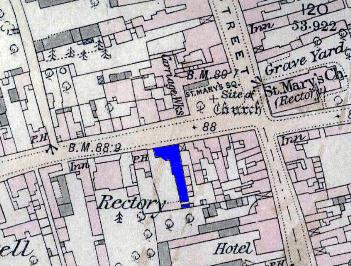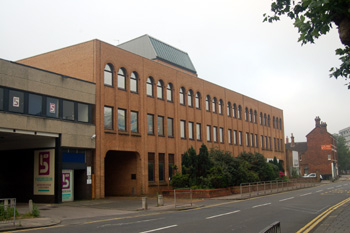The Angel Cauldwell Street Bedford

The Angel about 1900
The Angel Public House, 12 Cauldwell Street, Bedford [formerly the Griffin]
This establishment was a public house for around 250 years from the 17th century into the 20th. Bedfordshire and Luton Archives and Records Service has a full run of deeds for the property from 1600 until its purchase by Bedford brewer Peregrine Nash in 1799.
For most of the 17th century the premises seems to have simply been a cottage. In 1600 it was described as being a messuage in Bedford, Saint Mary in Cawdell Street abutting west on a curtilage (defined as an area of enclosed ground belonging to a dwelling) previously belonging to the now dissolved Warden Abbey, east on a tenement of a man named Baxter and extending from the Queen’s Highway [i.e. Cauldwell Street] to a garden of the Chamber of Bedford (this garden would later belong to Saint Mary’s Vicarage) [GK95/1]. At this date the cottage was conveyed by John Goodhall of Bedford, draper to John Harvey of Bedford, glover for £40.
After John Harvey’s death his widow Alice conveyed the cottage to Elizabeth, widow of Thomas Harvey, presumably a relation by marriage, for £10. John Goodhall had added to the land by a purchase from James Paley at some undisclosed date [GK95/2]. Elizabeth later married Thomas Gasley of Bedford, baker and in 1626 the couple mortgaged the cottage to Edward Crash, alias Baxter, who owned neighbouring property, for £20 [GK95/3]. In 1640 Elizabeth and her son, John Harvey of Whitechapel [Middlesex], silk weaver and his wife, Mary, conveyed the cottage to Samuel Gibbs of Bedford, cooper for £40 [GK95/4].
The next deed, of 1681, is the first to describe the property as a public house called the Griffin. The premises was mortgaged by Alice Barker, widow (Samuel Gibb’s daughter) and Susannah Clerke (formerly Gibbs) to John Pemberton of Bedford for £50 [GK95/6]. Next year the mortgage was assigned to the executors of Pemberton’s widow Mary [GK95/7] and in 1690 William Bayley and Alice, his wife (formerly Alice Barker) conveyed the Griffin to Henry Lowen of Bedford, vintner, and Margaret, his wife. Joining the Bayleys in the conveyance was a man named John Bunyan of Bedford, brazier. Sadly this was not the author of Pilgrim’s Progress, as he had died two years before!
In 1696 Henry and Margaret Lowen conveyed the Griffin to John Benson of Bedford for £100 [GK65/10] and three months later he sold it to Edward Brace of Cople and Joseph Wood of Cople, weaver, for £80 [GK95/12]. The following year Brace and Wood conveyed the public house to John Giddings of Bedford, bricklayer for £92 [GK95/13]. The next year Giddings mortgaged the property to William Staines of Bromham for £80 [GK95/11]. The fact that Staines was a bricklayer and raised money on mortgage may mean that the old premises was either altered or completely rebuilt at this time. Two years later Giddings took a £40 further advance from Staines [GK95/15] then in 1702 he conveyed the Griffin to Staines and Ely, his wife for £210 [GK65/17].

The Angel shown in blue on this 1901 map
In 1753 William, nephew of William Staines, and Mary, his wife, conveyed the public house, now called the Angel, to Richard Chamberlain of Bedford, blacksmith for £135 [GK95/19]. This was much less than the conveyance of 1702 and may have been of part of the site and later deeds mention that the property was divided into two at some point with one of the tenements being the Angel. It therefore seems likely that this occurred between 1702 and 1753 and that the name of the house changed at that time. Chamberlain immediately mortgaged the Angel to William Wilsher, innholder, who kept a Bedford inn called the Boat and Hearse. In 1771 Dinah Chamberlain, Richard’s daughter, conveyed the Angel to William Hill for £150 [GK95/23]. At this date the property was described as abutting west on the messuage of Thomas Hensman and east on the house of Richard Furness, used as the County Bridewell, or House of Correction, putting that building at 10 Cauldwell Street.
William Hill left the Angel to his wife Mary in his will of 1772, proved in 1773 [GK95/24] and she sold it to Peregrine Nash, a Bedford brewer, in 1799 for £280 [GK95/27]. This brewery became Newland and Nash Limited in 1897. This firm was bought out by Biggleswade brewers Wells and Winch in 1922 and they closed Newland and Nash’s Lurke Street brewery in 1924. On 7thFebruary that year they also closed the Angel. Wells and Winch were taken over by Suffolk brewers Greene King in 1961.
In 1911 an assessment of licensed premises in Bedford [Z720/214/2] noted that the tenant, Joseph Henry Busby, paid £20 per annum rent to Newland and Nash and supplemented his income by taking in lodgers at sixpence or a shilling a week (“not a big thing”). The premises comprised a cellar and, on the ground floor, a bar with three beer pulls, a tap room, a smoke room, a club room, a sitting room, a kitchen and a pantry. Five bedrooms lay on the first floor and two bedrooms on the second floor. Outside stood a stable for twelve horses (“big”), with a loft over and a big cart hovel in the yard. The valuer commented: “Big front” and described Busby as “a curious man”.
Interestingly, in 1937 a font, thought to have belonged to the medieval church of Saint Peter Dunstable opposite the Angel was given to Saint Mary's church. A local newspaper noted: "The font, which was used as a horse-trough in the yard of the "Angel" inn, Cauldwell Street, until it was rescued by the late Rev. P. Wyatt, stood in the latter's garden for some thirty years".
Today a modern commercial block stands on the site of the Angel, the Bridewell on the east side and the Shepherd and Dog public house on the west side.

The site of the Angel in July 2008
References:
- GK95/1: conveyance of cottage from John Goodhall to John Harvey for £40: 1600;
- GK95/2: conveyance of cottage from Alice Harvey to Elizabeth Harvey for £10: 1625;
- GK95/3: mortgage by Thomas Gasley and Elizabeth his wife (formerly Elizabeth Harvey) to Edward Crash alias Baxter: 1626;
- GK95/4: conveyance of cottage from Elizabeth Gaseley and her son John Harvey to Samuel Gibbs for £40: 1640;
- GK95/6: Mortgage of the Griffin by Alice Barker, daughter of Samuel Gibbs and Susannah Clarke, her mother to John Pemberton: 1681;
- GK95/7: assignment of mortgage from John Pemberton’s executors to executors of the will of Mary Pemberton: 1682;
- GK95/8: conveyance of Griffin from William Bayley and Alice, his wife and John Bunyan of Bedford, brazier to Henry Lowen: 1690;
- GK95/10: conveyance of Griffin from Henry Lowen to John Benson for £100: 1696;
- GK95/12: conveyance from John Benson to Edward Brace and Joseph Wood for £80: 1696;
- GK95/13: conveyance from Edward Brace and Joseph Wood to John Giddings for £92: 1697;
- GK95/14: mortgage from John Giddings to William Staines: 1698;
- GK95/15: further advance: 1700;
- GK95/16: assignment of mortgage to Henry Lowen: 1702;
- GK95/17: Griffin conveyed by John Giddings to William Staines for £210: 1702;
- QSR 1751/42: recognizance of licensee: 1751;
- CRT130 Bedford 155: recognizance of licensee: 1752;
- QSR1753/31: recognizance of licensee: 1753;
- GK95/19: Angel conveyed from William Staines (nephew of the previous William Staines) to Richard Chamberlain for £135: 1753;
- GK95/21: mortgage from Richard Chamberlain to William Wilsher: 1753;
- GK95/23: conveyance of Angel from Dinah Chamberlain to William Hill: 1771;
- GK95/24: will of William Hill leaving Angel to his wife Mary: 1772, proved 1773;
- GK161/1: abstract of title of William Joseph Nash to brewery and licensed houses: 1794;
- GK95/27: Angel conveyed by Mary Hill to Peregrine Nash for £280: 1799;
- X380/35: assignment of brewery and licensed premises: 1820;
- CLP13: recognizances of ale house licencees:1822-1828;
- PSBB1/1:changes of licensee noted in petty sessions ledger: 1840-1844;
- GK161/2: mortgage of brewery and licensed houses: 31 Jul 1867;
- GK161/5: mortgage of brewery and licensed houses: 31 Oct 1882;
- GK162/4: reconveyance of mortgaged property: 1895;
- GK3/1: conveyance from individual owners to newly formed Newland and Nash Limited: 1897;
- Z50/9/789: photograph: c.1900;
- BorBP 4440: plans for rebuilding of w.c.: 1904;
- P88/28/12: photograph: c.1905;
- Z720/214/2: assessment of licensed premises in Bedford: 1910-1911
Licensees: note that this is not a complete list; entries in italics refer to licensees where either beginning or end, or both, dates are not known:
before 1681: Henry Latham;
1681-1690: Richard Sherriffe;
1696--1698: John Benson;
1698--1702: John Giddings;
1709: Henry Williamson;
1751-1753: Thomas Day, carpenter;
1771: James Mansfield;
1785: William How;
1792-1798: John Biggs;
1822-1839: George Francis;
1840-1841: Rebecca Francis;
1843-1844: David Francis;
1850: John Smith;
1851: James Smith;
1853-1854: John Smith;
1858: Mark Millard;
1861: John Howkins;
1864-1869: Theophilus Abbott
1876-1877: Charles Stebbing;
1880-1904: Bartholomew Creed [house placed out of bounds by the military authorities on 25 Jun 1901 due to frequent disturbances; convicted on 21 Jul 1903 of selling adulterated gin - fined £2 with £1/15/8 costs]
1904-1905: Herbert Dean;
1905: Caroline Hermon;
1905-1907: Charles Barker;
1907-1920: Joseph Henry Bushby;
1920: Frederick William Buckley
Public house closed and licence transferred to Angel, Elstow Road 7 Feb 1924